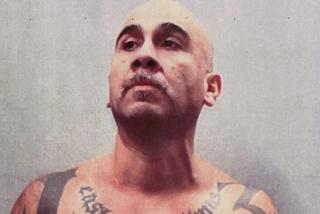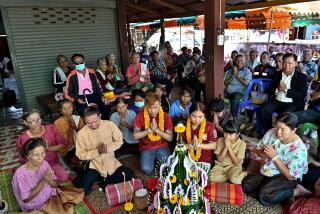Philippine Rebels’ Main Cause Is Cash
- Share via
MANILA — If there is one thing the Abu Sayyaf rebels of the southern Philippines have learned in the last 15 months, it is that crime pays.
Until last year, they were a struggling gang of Islamic bandits subsisting on ransom payments from occasional kidnappings of local businesspeople. Then they staged a daring raid on an island resort in Malaysia, snatched 20 foreigners and a Filipino and netted a ransom windfall: as much as $25 million paid by Libya.
Now the Abu Sayyaf gang, swelling with new recruits and sometimes better equipped than the Philippine military, has created a new international incident: the kidnapping of three Americans from an island resort in the Philippines.
Authorities were hopeful Thursday that one of the hostages, Guillermo Sobero of Corona, remains alive despite the kidnappers’ claim that they had cut off his head. An intensive three-day search has not turned up his body. A rebel leader tried unsuccessfully Thursday to peddle a video to a U.S. television network purportedly showing Sobero’s execution.
The Abu Sayyaf rebels and their hostages apparently are holed up on Basilan island in the southern Philippines, but the military has had difficulty determining their location in the dense jungle.
President Gloria Macapagal Arroyo has vowed to “crush” the rebels, but it is a high-risk strategy that could lead to a lengthy standoff and jeopardize the lives of the hostages, which include 25 Filipinos.
“They live by the draconian code of an eye for an eye and a tooth for a tooth,” the president declared. “We have responded in kind.”
Abu Sayyaf, which means Father of the Sword, was formed 10 years ago amid the poverty, despair and Islamic extremism of the southern Philippines.
Christians, Muslims Went Head to Head
The region, made up of hundreds of islands, has historically been a zone of conflict between Muslims and Christians. It is here that the spread of Islam from the south and west was halted hundreds of years ago by the arrival of Spanish colonialists and Catholicism. The two religions have coexisted uneasily since, with Catholicism practiced by a majority of Filipinos.
From 1972 until 1996, Muslim rebels led by the Moro National Liberation Front waged a war of separatism that claimed at least 100,000 lives and left 300,000 homeless. In 1996, the group signed a treaty with the government giving the former rebels a degree of autonomy and power.
Wealthy Middle Eastern sponsors of international terrorism, including Libya, helped fund Islamic groups in the region, and some Philippine fighters were trained in the Middle East. One of them was Abdujarak Abubakar Janjalani, who fought in Afghanistan in the 1980s against the Soviet Union.
Unlike many Filipinos, Janjalani believed in a strict form of Islam that forbids dancing and movies. After his return to the Philippines, he broke with his former allies of the MNLF and formed Abu Sayyaf--the same name he had used in Afghanistan.
In its first attack, the group bombed a missionary ship in the southern city of Zamboanga in 1991 and killed two foreign evangelists. The assault was the start of a series of kidnappings, raids and bombings that claimed dozens of lives.
In 1995, Abu Sayyaf raided the town of Ipil, taking 30 hostages and killing at least 53 other people in an orgy of arson, shooting and looting. Philippine military intelligence concluded that the group’s actions were an attempt to draw attention to itself and attract funds from Middle East sponsors.
“I look at the whole activity in the south as driven by money,” said Rex Robles, a former domestic intelligence chief. “Abu Sayyaf staged attacks to show it was a force and should receive funding.”
In December 1998, Janjalani was ambushed by the military and killed. Authorities thought that Abu Sayyaf might be finished, but it regrouped under the leadership of his brother, Khadaffy. Disaffected Islamic fighters who opposed the 1996 peace deal gravitated to Abu Sayyaf.
Any pretense of being an ideologically motivated group died with the elder Janjalani. In March 2000, Abu Sayyaf kidnapped about 58 people, including priests, teachers and children, from a Basilan school.
Pursued by government forces, the rebels then raided a resort on Malaysia’s Sipadan island, a popular diving area off Borneo not far from the Philippines, and took 21 hostages, most of them divers from Germany, France and South Africa.
The hostages were freed when Libyan leader Moammar Kadafi paid the estimated $25 million in ransom. Ostensibly a goodwill gesture to release the hostages, the payment was also a way of subsidizing the activities of the rebel group, financing further kidnappings and promoting instability in the region.
“Libya found a way to give money overtly to enhance its presence,” said Robles, a retired Philippine navy officer.
It is unclear why the government of then-President Joseph Estrada approved the Libyan payment, knowing that it would help strengthen Abu Sayyaf. Some suggest that officials involved in the decision received a share of money themselves.
Estrada has since been removed from office and is under arrest, awaiting trial on unrelated corruption charges.
American Walked Into the Rebels’ Camp
One of the most bizarre episodes involving Abu Sayyaf was the kidnapping of Jeffrey Schilling of Oakland, a black American convert to Islam. He walked into the rebels’ camp in August with his new Filipino wife--the cousin of one Abu Sayyaf leader and the widow of another. After the rebels talked with Schilling for hours, they seized him.
Schilling has alternately been portrayed as a naive idealist devoted to Islam, a gun merchant and a CIA agent. The reason for his visit to the base has never been clear. He was freed in April after Abu Sayyaf threatened to behead him and Philippine soldiers raided the camp where he was being held.
Sobero and missionaries Martin and Gracia Burnham of Wichita, Kan., were taken May 27 from a resort on the island of Palawan in the southwestern Philippines.
The speedboats used in the kidnapping, said to have 1,000-horsepower engines, allegedly were purchased with the Libyan money, as was the rocket launcher the rebels used to kill an army captain trailing the kidnappers.
“They are now well-equipped, and they have more resources this time,” said Asiri Abubakar, a professor of Asian studies at the University of the Philippines. “The Philippine government is facing greater risks. It is not entirely of their own making, but the government is a victim of what happened in the past.”
As the army and navy have chased the gang from island to island and through the jungle, the rebels have dragged their captives along, killing at least two Filipinos. Nine hostages escaped when the group was surrounded at a hospital, but the kidnappers escaped with the rest. Several rebels have been killed in gun battles with government forces.
CNN Says It Refused to Buy Rebel Video
Meanwhile, CNN reported on its Web site that a man claiming to be an Abu Sayyaf leader offered to sell a videotape as proof of Sobero’s death. CNN said it refused to buy the purported film.
Police Gen. Thompson Lantion, who visited troops on Basilan on Thursday, said that allowing the Libyan payments was a mistake that Arroyo is trying to correct by taking a tough stance.
A government force of 3,500 is gathering on Basilan, and the military is preparing to mobilize civilian units there. “Hopefully we can resolve this in the next two weeks or so,” the general said.
More to Read
Sign up for Essential California
The most important California stories and recommendations in your inbox every morning.
You may occasionally receive promotional content from the Los Angeles Times.










